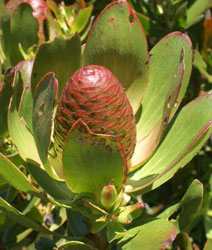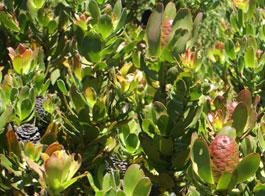Leucadendron strobilinum
Leucadendron strobilinum (L.) Druce
Family: Proteaceae
Common names: Peninsula conebush
SA Tree No: 78
Introduction
Leucadendron strobilinum is an eye-catching shrub that is ideal for display in a fynbos garden.

Description
Description
Leucadendron strobilinum is a large, single-stemmed shrub that branches from the base. It grows up to 2.6 m tall. The leaves are dark green and oval. The leaf tips are red and recurved with a fine point. The fruiting cones are ovoid and hairless and contain flat, winged seeds. It flowers from September-October.

Conservation Status
Status
It is listed as Near Threatened on the Red List of South African plants.
Distribution and habitat
Distribution description
It occurs on the Cape Peninsula, and the distribution ranges from Table Mountain to Kommetjie. It grows on damp, rocky slopes.
Derivation of name and historical aspects
History
The word Leucadendron is derived from the Greek word leucos, meaning white, and dendron, meaning a tree, referring to the silver tree, Leucadendron argenteum. Strobilinum comes from the Greek strobilos (cone) and is a reference to the resemblance of this plant's cones to pine cones.
Ecology
Ecology
The plants regenerate from seed. The seeds are stored in the cones on female plants from which they are released after fire. The seeds are dispersed by wind. Leucadendron strobilinum has plants of separate sexes, the male and female flowers occur on separate plants. Flowers are pollinated by small beetles.
Growing Leucadendron strobilinum
Grow

Leucadendron strobilinum can be grown from seed or cuttings. Sow seeds in autumn in a well-drained medium. Press the seeds into the surface and cover with a thin layer of river sand. Keep the seeds moist. Germination occurs after about 3–4 weeks. After the first set of leaves has developed, the seedlings can be transplanted into a well-drained medium.
To propagate from cuttings use tip cuttings. Remove the leaves from the bottom of the cutting, apply a rooting hormone and place in a well-drained rooting medium of bark and polystyrene . Keep cuttings moist, not wet. Rooting takes about 6 weeks. Harden off for 3 weeks and transplant into individual containers filled with well-draining, acidic soil. Keep root disturbance to a minimum, as the plants are susceptible to Phytophthora, a root pathogen. The plants can be used as a filler in a fynbos garden.
References
- Goldblatt, P. & Manning, J. 2000.Cape plants. A conspectus of the Cape flora of South Africa. Strelitzia 9. National Botanical Institute, Pretoria & Missouri Botanical Garden Press, Missouri.
- Leistner, O.A. (ed.). 2000. Seed plants of southern Africa : families and genera. Strelitzia 10. National Botanical Institute, Pretoria.
- Rebelo, A.G. 1995. A field guide to the proteas of southern Africa, edn 2. Fernwood Press, Vlaeberg.
- Website: Protea Atlas Project. http://protea.worldonline.co.za.
Credits
Olivia Tyambetyu
Kirstenbosch National Botanical Garden
January 2012
Plant Attributes:
Plant Type: Shrub
SA Distribution: Western Cape
Soil type: Sandy, Loam
Flowering season: Spring
PH: Acid, Neutral
Flower colour: Green, Cream, Yellow
Aspect: Full Sun
Gardening skill: Average
Special Features:
Horticultural zones







Rate this article
Article well written and informative
Rate this plant
Is this an interesting plant?
Login to add your Comment
Back to topNot registered yet? Click here to register.